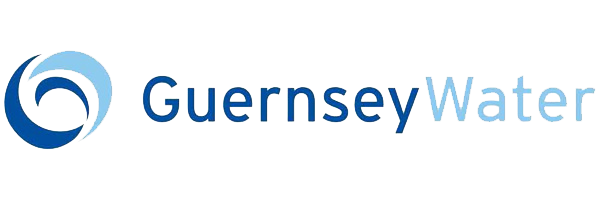Juas WTW (2019)
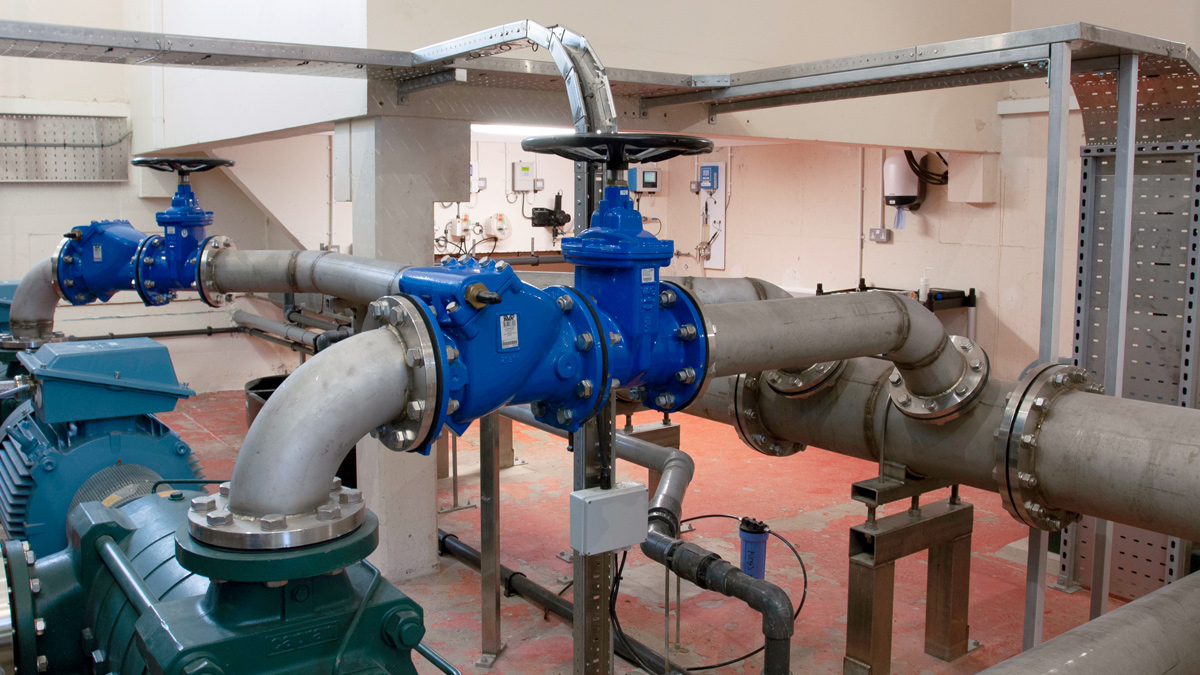
High lift pump house pipework after UV treatment - Courtesy of Guernsey Water
Guernsey is an island with a population of around 65,000. It has been served by three water treatment works; two (at Longue Hougue and St Saviour) utilising a membrane technology, and the third based on a more traditional rapid gravity filtration (RGF) process. The operation, control and reliability of the Longue Hougue plant had for several years been the cause of frequent issues, with difficulties of managing control of water production, multiple breakdowns and deemed high cost of operation compared with the RGF at Kings Mills WTW. It was for these reasons that a overall review of the water treatment strategy was undertaken to assess whether the existing arrangements were suitable and effective for the long term production of water for the island.
Background
Within Guernsey is a fourth WTW, at Juas, that was decommissioned around 2010 when the Longue Hougue plant was brought in line.
The average total demand on the island is approximately 12.5 Ml/d, with a peak of around 24 Ml/d in the summer months (based on previous 10-year monitoring). The capacity of the existing three WTWs was around 30 Ml/d, split equally between the three operational WTWs at 10 Ml/d. This enables resilience in the system, with one works able to be taken out of operation at any time during an emergency or for maintenance work etc without compromising supplies to residents in the short term.
To assist Guernsey Water (GW) with the review, Mott MacDonald (MM) was commissioned to undertake an assessment of all four WTWs on the island with regard to their retention, operation, decommissioning over the medium term horizon.
Water treatment strategy
The review was undertaken based on the following scope:
- Confirmation of GW objectives through discussion with the project team and a review of existing processes.
- Identification of defects and deficiencies in existing arrangement at Longue Hougue.
- Consultation with GW operations to define a scope of work to improve the processes at Juas WTW to meet current and future compliance requirements.
- Development of a scope of works to improve processes (where possible) at St Saviours and Kings Mills WTWs.
- Liaison with GW project team to gain information needed to carry out cost analysis (unit cost, CAPEX, OPEX and whole life costs) across all four treatment sites.
- Facilitate and participate in a long and shortlist option workshop to evaluate options identified.Manage and input to the risk identification and analysis process, including but not limited to:
- Risks to raw water supply – not including Water Resource Management Planning issues, which are being addressed separately by GW.
- Risks to supply – storage capacity, treatment strategy.
- Risks to treatment – nitrates, pH correction, single stage treatment, etc.
- Evaluation of residual risk and associated cost estimation.
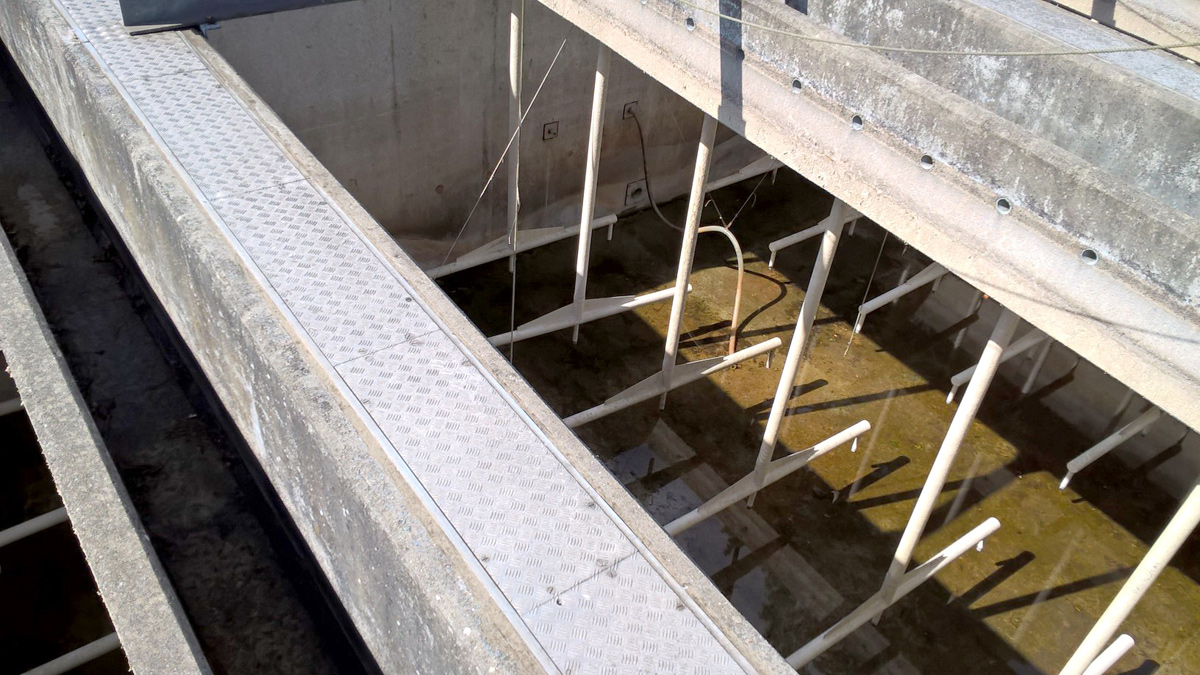
Filter clarifier cell showing T-bars prior to cleaning and refurbishment – Courtesy of Guernsey Water
After initial assessment of WTW performance and cost analysis, a series of workshops were held between GW and MM staff to draw up list of options for the medium-to-long term provision of water treatment and the following options were considered:
- J1: Reinstate Juas WTW: Upgrade the currently mothballed works at Juas to enable water production, and then take Longue Hougue offline.
- KM1: Address raw water taste and odour issues at Kings Mills: These issues to be resolved through the addition of activated carbon.
- LH2: Retain Longue Hougue for peak lopping only: Maintain Longue Hougue as a peak lopping plant with Juas reinstated for duty flows.
- LH3: Improve Longue Hougue: Take Longue Hougue offline to reduce/eliminate unreliability at the works by addressing the operating software and process equipment issues.
- SS2: Pre-membrane treatment at St Saviours: Installation of a dissolved air flotation (DAF) plant to improve pre-treatment at the works.
- SS13: Reduce disinfection by-products at St Saviours: Reduction/removal of disinfection by products at the works through the installation of an ultraviolet (UV) unit.
- SS14: Taste and Odour removal at St Saviours: These issues will be resolved through the addition of activated carbon.
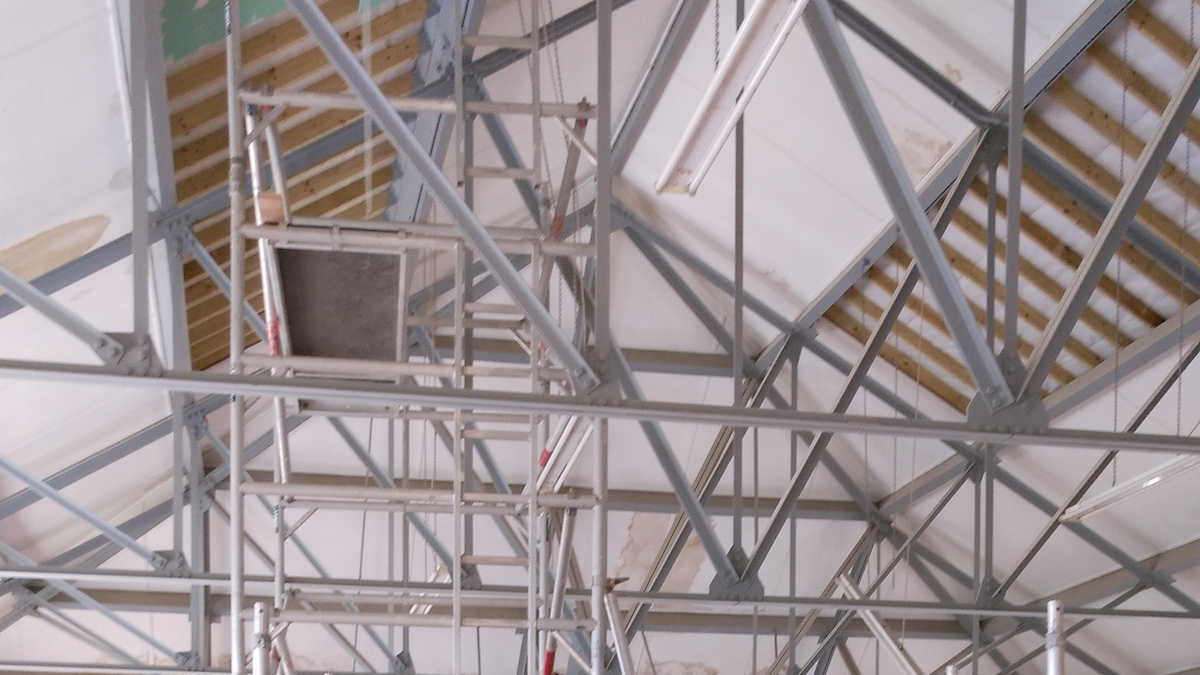
Refurbishment of chemical store and dosing room – Courtesy of Guernsey Water
Strategy recommendation
Based on the team workshops (shortlist, long-list and risk) and the evaluations detailed in this report, the recommended option is to reinstate Juas with PAC dosing and take Longue Hougue offline (J1) while also removing the taste and odour issues at Kings Mills with PAC dosing (KM1). J1 ranked highly in both the long-list and shortlist workshop and has the major benefit of a plant that is simpler to maintain and operate, with a less energy intensive process than Longue Hougue.
Option KM1 was also recommended as the Kings Mills works is a key component of the Guernsey Water supply network with the flexibility to draw raw water from a number of sources and the strategic plant location. The only process shortcoming identified is the inability to remove taste and odour, which this option will address cost effectively.
As the decommissioning of Longue Hougue is recommended under option J1, an analysis of the write-off costs was completed. This analysis concluded that there is a marginal saving of approximately 4% achieved by retaining Longue Hougue WTW for the full 15 year write–off period. However this saving assumes that no works are undertaken at Longue Hougue to improve the reliability or operability of the plant. The saving is not significant enough to overcome operating concerns at Longue Hougue.
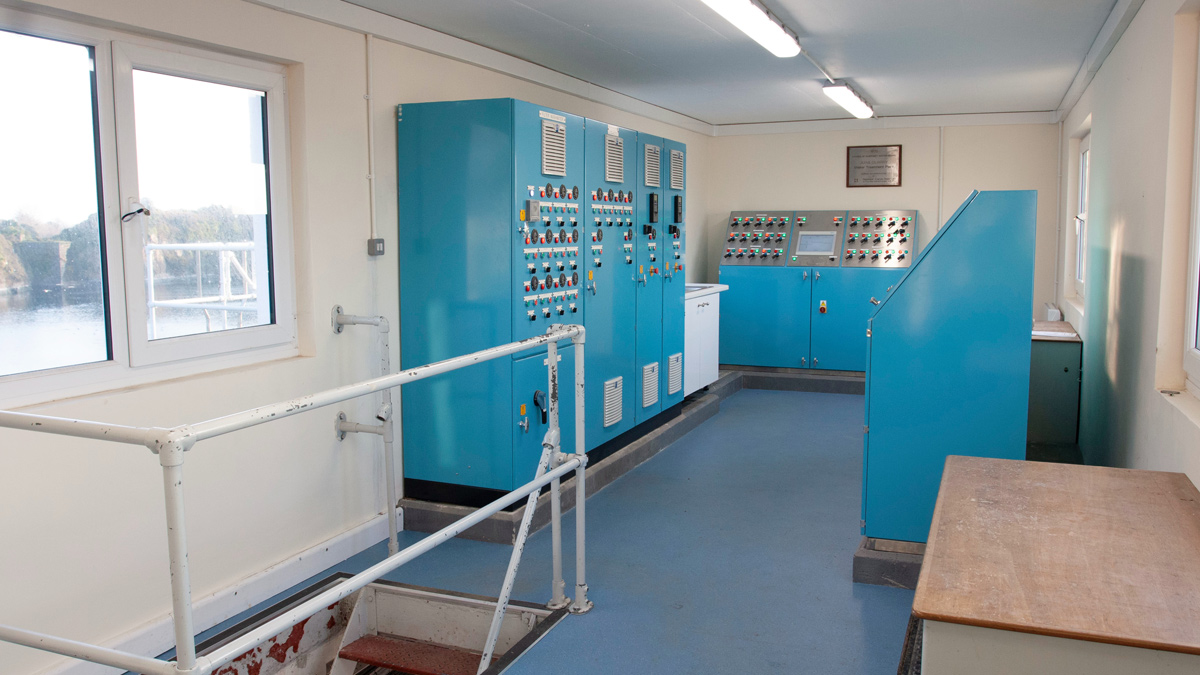
Completed on site control room including MCC panels – Courtesy of Guernsey Water
Juas WTW Recommissioning
Juas WTW was originally a granite quarry. States Waterworks Department brought the site and converted it to a WTW in the 1960s. Initially the site was built as a pressure filter plant, extracting flows from Juas and Queens quarries, with raw water feeds from various other raw water sources. During 1975-76 the works were renovated with the addition of 3 (No.) rapid gravity filters (RGFs) a clean water tank and a high lift pumping station delivering into supply. The high lift pumping station was added later in 1978.
Raw water supply
Although situated adjacent to the third largest water storage sites (Juas quarry; approximately 580 Ml) that originally supplied water to the WTW, Juas can also be fed directly from other storage facilities via the raw water network system. However, all the low-lift pumps in Juas quarry were replaced as part of the project scope. These were similar to the existing, floating pumps on the reservoir. As the Juas quarry continued to be a source/storage of raw water, even when the WTW had been decommissioned, its de-stratification system had been retained and continues as part of the overall process within the new works.
Clarification
The existing concrete structure and associated ancillary walkways and railing was in good condition and did not require any remedial work. The sludge hoppers had undergone severe degradation and were replaced as part of the scheme, together with new desludge/drain-down facility to allow emptying of the tanks to sewer without resorting to the need for temporary pipework.
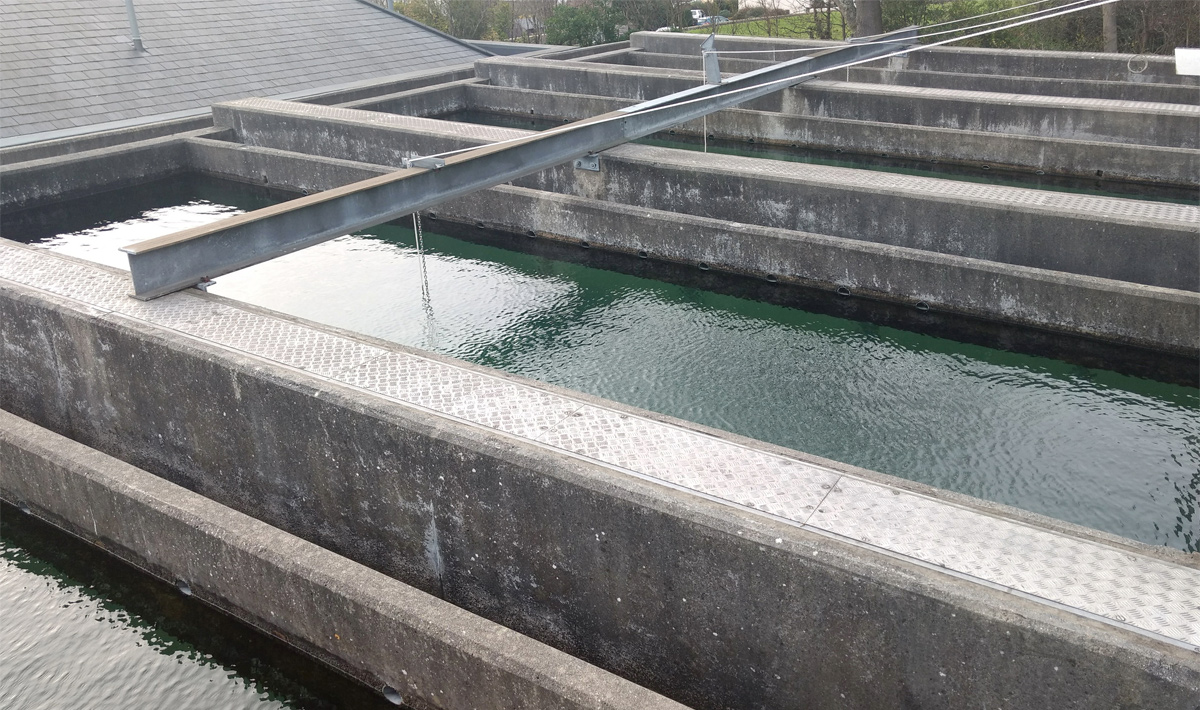
Clarifier tanks brought back into commission – Courtesy of Guernsey Water
Rapid gravity filters
The WTWs has 3 (No.) RGFs that were constructed when the treatment works was upgraded in 1976. Although the filter media had not been replaced since that date the filter bed nozzles had been replaced in 1984 with plastic material. Again, the concrete structures were found to be in good condition and did not require further work. However all pipework was replaced with equivalent stainless steel components, and in view of the forecast long term design life for the element it was decided that replacement of filter media and nozzles would be necessary.
Filter backwash
All the civil elements of the process were in good condition, however all pipework, air blower and pumps were found to be corroded and/or unusable and had to be replaced. In order to provide greater control over the process and greater effectiveness of the process, the pumps were replaced with units incorporating variable speed drives.
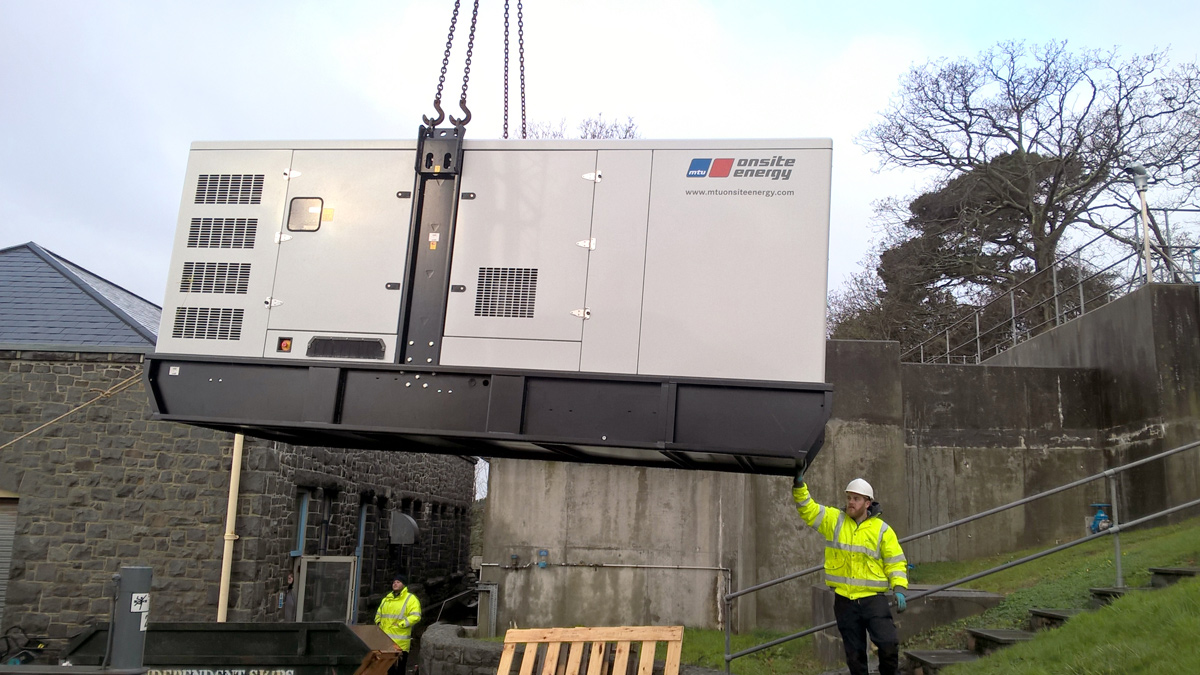
Delivery of standby generator power pack – Courtesy of Guernsey Water
UV disinfection treatment
Consideration was given to the disinfection process that would be most suitable for the site. Ultimately, a duty/standby arrangement of 2 (No.) UV units from Trojan Technologies was selected.
Juas WTW – Supply chain/key participants
- Main works: Guernsey Water
- Installation of MCC panels & SCADA integration: Boultings Group Limited
- UV disinfection: Trojan Technologies
- Valves: Festo Ltd
- Pumps: Caprari Pumps Ltd
Summary
The works to recommission the Juas WTW commenced in May 2018 following approval of the scheme by Guernsey Water and the States Trading Supervisory Board, and was brought back into service in February 2019.
The total capital costs of the Works was £1.7m. Most of Guernsey Water’s water treatment maintenance and enhancements at the other three WTW sites is undertaken via in-house staff, so the recommissioning of the Juas site allowed good familiarisation of the complete treatment process and equipment to be used in the long term.


